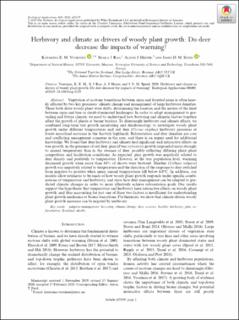| dc.contributor.author | Vuorinen, Katariina | |
| dc.contributor.author | Rao, Shaila | |
| dc.contributor.author | Hester, Alison J. | |
| dc.contributor.author | Speed, James David Mervyn | |
| dc.date.accessioned | 2020-09-28T08:04:20Z | |
| dc.date.available | 2020-09-28T08:04:20Z | |
| dc.date.created | 2020-04-02T12:59:37Z | |
| dc.date.issued | 2020 | |
| dc.identifier.issn | 1051-0761 | |
| dc.identifier.uri | https://hdl.handle.net/11250/2679858 | |
| dc.description.abstract | Vegetation at ecotone transitions between open and forested areas is often heavily affected by two key processes: climate change and management of large herbivore densities. These both drive woody plant state shifts, determining the location and the nature of the limit between open and tree or shrub‐dominated landscapes. In order to adapt management to prevailing and future climate, we need to understand how browsing and climatic factors together affect the growth of plants at biome borders. To disentangle herbivory and climate effects, we combined long‐term tree growth monitoring and dendroecology to investigate woody plant growth under different temperatures and red deer (Cervus elaphus) herbivory pressures at forest–moorland ecotones in the Scottish highlands. Reforestation and deer densities are core and conflicting management concerns in the area, and there is an urgent need for additional knowledge. We found that deer herbivory and climate had significant and interactive effects on tree growth: in the presence of red deer, pine (Pinus sylvestris) growth responded more strongly to annual temperature than in the absence of deer, possibly reflecting differing plant–plant competition and facilitation conditions. As expected, pine growth was negatively related to deer density and positively to temperature. However, at the tree population level, warming decreased growth when more than 60% of shoots were browsed. Heather (Calluna vulgaris) growth was negatively related to temperature and the direction of the response to deer switched from negative to positive when mean annual temperatures fell below 6.0°C. In addition, our models allow estimates to be made of how woody plant growth responds under specific combinations of temperature and herbivory, and show how deer management can be adapted to predicted climatic changes in order to more effectively achieve reforestation goals. Our results support the hypothesis that temperature and herbivory have interactive effects on woody plant growth, and thus accounting for just one of these two factors is insufficient for understanding plant growth mechanics at biome transitions. Furthermore, we show that climate‐driven woody plant growth increases can be negated by herbivory. | en_US |
| dc.language.iso | eng | en_US |
| dc.publisher | Wiley | en_US |
| dc.rights | Navngivelse 4.0 Internasjonal | * |
| dc.rights.uri | http://creativecommons.org/licenses/by/4.0/deed.no | * |
| dc.title | Herbivory and climate as drivers of woody plant growth: Do deer decrease the impacts of warming? | en_US |
| dc.type | Peer reviewed | en_US |
| dc.type | Journal article | en_US |
| dc.description.version | publishedVersion | en_US |
| dc.source.journal | Ecological Applications | en_US |
| dc.identifier.doi | 10.1002/eap.2119 | |
| dc.identifier.cristin | 1804973 | |
| dc.relation.project | Norges forskningsråd: 262064 | en_US |
| dc.description.localcode | © 2020 The Authors. Ecological Applications published by Wiley Periodicals LLC on behalf of Ecological Society of America This is an open access article under the terms of the Creative Commons Attribution-NonCommercial-NoDerivs License, which permits use and distribution in any medium, provided the original work is properly cited, the use is non-commercial and no modifications or adaptations are made. | en_US |
| cristin.ispublished | true | |
| cristin.fulltext | original | |
| cristin.qualitycode | 1 | |

